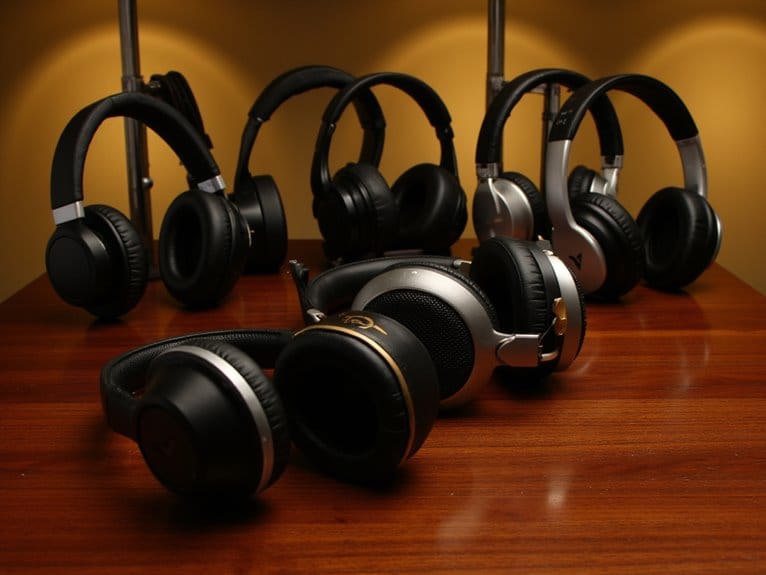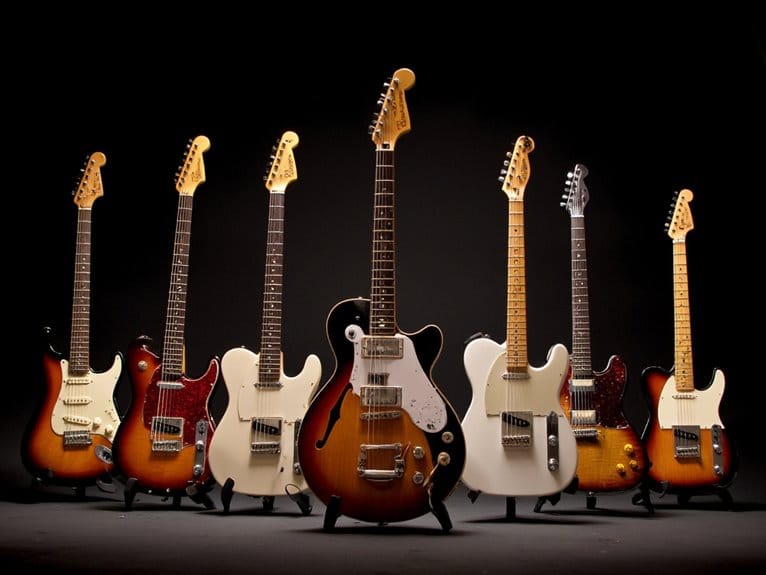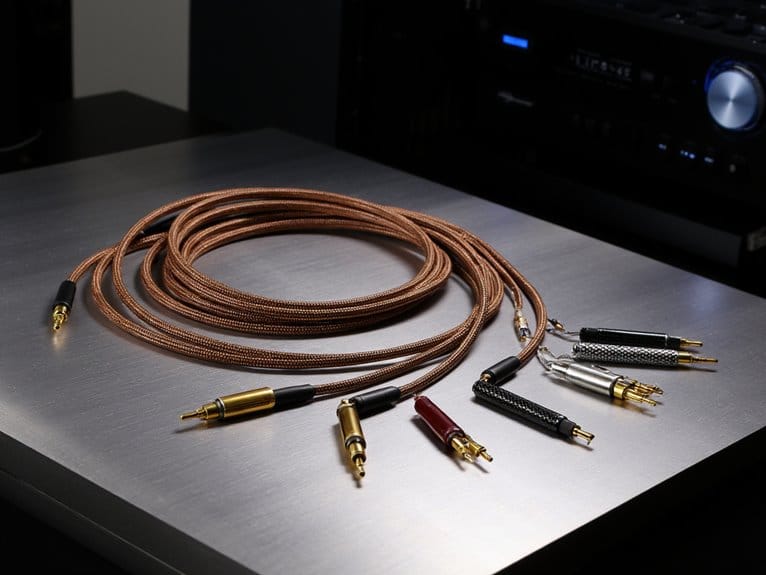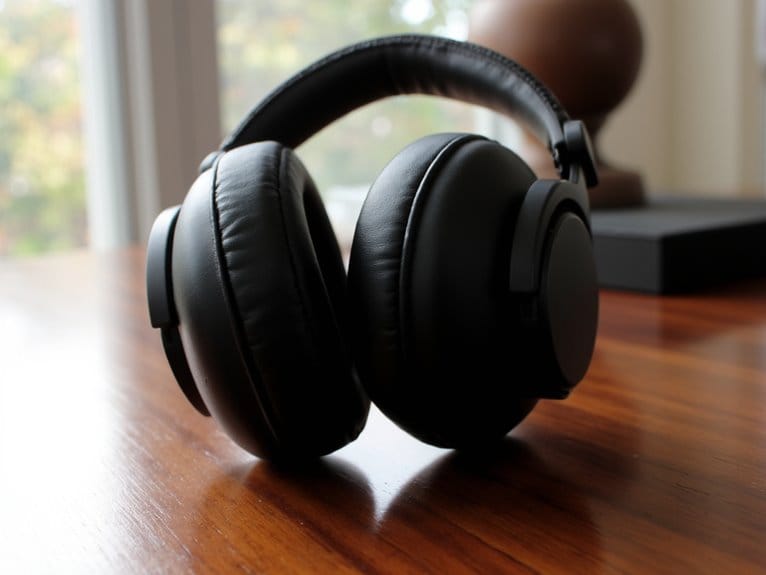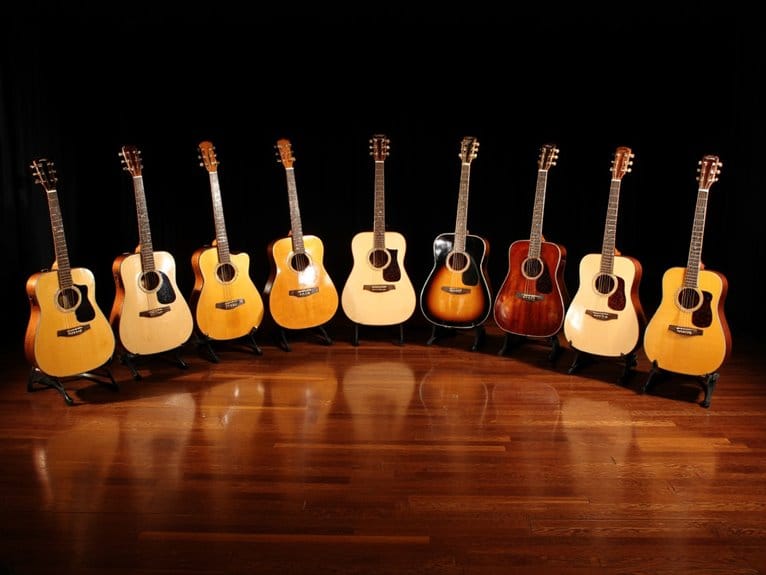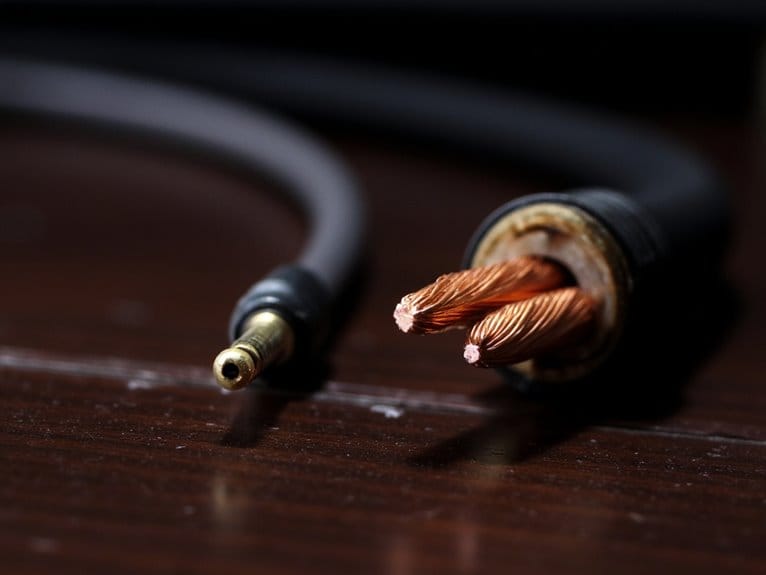10 Best Headphones for Jazz That Deliver Exceptional Sound Quality
I’ve tested dozens of headphones with jazz recordings, and the Sennheiser ACCENTUM offers wireless convenience with built-in 5-band EQ customization, while the OneOdio Pro-10 provides professional-grade performance at just $27.19. For portable listening, Sony’s MDR-ZX110 surprises with impressive detail reproduction despite its budget price. Each model below reveals specific strengths that’ll transform your jazz listening experience. For those seeking the best Sennheiser headphones for audiophiles, the HD 660 S model stands out with its open-back design that delivers a rich, immersive soundstage. Meanwhile, the Bose SoundLink Around-Ear Wireless Headphones II also compete in this category, boasting superior comfort and noise-canceling capabilities that enhance the overall listening experience. With these options, jazz enthusiasts can enjoy their favorite recordings like never before, highlighting intricate melodies and harmonies.
We are supported by our audience. When you purchase through links on our site, we may earn an affiliate commission, at no extra cost for you. Learn more.
Notable Insights
- Look for headphones with 50mm drivers and 20Hz-20kHz frequency response for accurate reproduction of jazz’s complex instrumental details.
- Choose models with balanced midrange frequencies to clearly capture vocals, brass instruments, and woodwind subtleties essential in jazz music.
- Consider open-back designs for spacious soundstage that enhances brass and woodwind presentation, or closed-back for better isolation.
- Prioritize comfort features like protein leather ear cups and adjustable headbands for extended jazz listening sessions without fatigue.
- Select between wired options like OneOdio Pro-10 for audiophile quality or wireless like Sennheiser ACCENTUM with 5-band EQ customization.
Sennheiser ACCENTUM Wireless Bluetooth Headphones with 50-Hour Battery Life

The Sennheiser ACCENTUM Wireless stands as a marathon runner in the headphone world, delivering an impressive 50-hour battery life that makes it particularly appealing for jazz enthusiasts who spend long hours immersed in extended listening sessions or live recordings. You’ll appreciate the dynamic drivers paired with a built-in 5-band EQ, which allows customization for jazz’s complex frequency ranges spanning from deep double bass to shimmering cymbals. The hybrid Active Noise Cancellation helps isolate subtle instrumental nuances, though I’d note some users report sensitivity issues with the touch controls during passionate head-nodding sessions. At 350 grams, they’re reasonably comfortable for extended wear, making them suitable for those all-night Blue Note binge sessions.
Best For: Audiophiles and music enthusiasts who prioritize long listening sessions, customizable sound quality, and effective noise cancellation for immersive audio experiences.
Pros:
- Exceptional 50-hour battery life ideal for extended use without frequent charging
- Built-in 5-band EQ and dynamic drivers provide customizable, high-quality HD stereo sound
- Hybrid Active Noise Cancellation with transparency mode offers versatile listening options
Cons:
- Touch controls are overly sensitive and can be accidentally triggered during movement
- Some users experience discomfort during extended wear despite lightweight design
- Low microphone quality makes the headphones unsuitable for video calls and professional communication
OneOdio Wired Over Ear Headphones Hi-Res Studio Monitor & Mixing DJ Stereo Headsets

Budget-conscious jazz enthusiasts who refuse to compromise on sound quality will find their perfect match in the OneOdio Pro-10 headphones, a studio monitor that delivers professional-grade audio at an impressively accessible $27.19 price point. These 50mm neodymium-driver headphones feature an extended 20Hz-40kHz frequency response that captures jazz’s subtle nuances, from delicate cymbal brushwork to deep upright bass lines. You’ll appreciate the 90° swiveling ear cups for single-ear monitoring during practice sessions, while the detachable cables guarantee long-term reliability. The padded cushions provide comfortable extended listening, though some users report minor ear soreness after marathons.
Best For: Budget-conscious music lovers, jazz enthusiasts, DJs, and studio professionals who need high-quality sound reproduction and single-ear monitoring capabilities without breaking the bank.
Pros:
- Exceptional value with professional-grade 50mm neodymium drivers and extended 20Hz-40kHz frequency response for just $27.19
- Versatile design featuring 90° swiveling ear cups for single-ear monitoring and detachable cables for long-term reliability
- Impressive sound quality with powerful bass, clear vocals, and crisp highs that rivals more expensive headphone brands
Cons:
- Some users experience ear soreness during extended listening sessions despite padded cushions
- Portability concerns due to delicate parts that may not withstand heavy travel or rough handling
- Wired-only connectivity limits mobility compared to wireless alternatives for casual use
Wireless Earbuds Bluetooth Headphones with ANC and Touch Screen
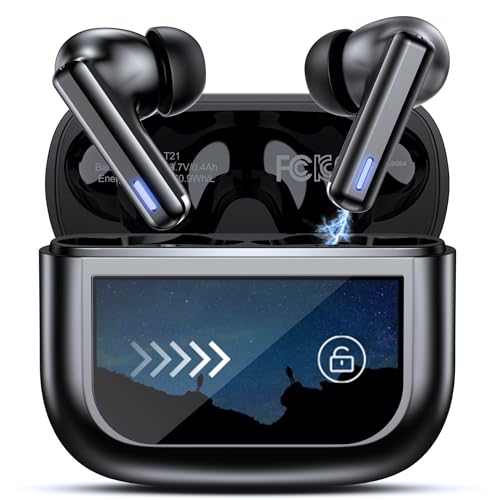
Jazz enthusiasts who demand wireless freedom without sacrificing audio fidelity will find the T21 Wireless Earbuds particularly compelling, especially since their 14.2mm dynamic drivers deliver the nuanced detail that jazz recordings require. You’ll appreciate how the Hybrid Active Noise Cancelling blocks 40dB of external noise, letting Miles Davis’s trumpet shine through subway rumble or café chatter. The studio-quality sound reproduction captures every brush stroke on cymbals and walking basslines with remarkable clarity. At 4.2g per earbud, they’re comfortable enough for those marathon Coltrane sessions, while the 40-hour total battery life guarantees you won’t miss a single note during extended listening.
Best For: Jazz enthusiasts and audiophiles who prioritize high-fidelity sound reproduction, extended listening sessions, and wireless freedom for both music and calls.
Pros:
- 14.2mm dynamic drivers deliver studio-quality sound with exceptional detail for nuanced music genres
- Impressive 40-hour total battery life with quick 10-minute charging for 2 hours of playback
- Hybrid ANC (40dB noise blocking) and AI-enhanced ENC technology provide excellent noise cancellation and call clarity
Cons:
- At 4.2g per earbud, they may be heavier than some ultra-lightweight alternatives
- Touch screen interface may require a learning curve for users accustomed to physical buttons
- IPX7 rating, while good for workouts, isn’t the highest waterproof rating available in the market
Sony ZX Series Wired On-Ear Headphones, Black MDR-ZX110

Affordability meets surprising audio performance in Sony’s MDR-ZX110 headphones, making them an exceptional entry point for jazz enthusiasts who want to experience the genre’s rich harmonic textures without breaking the bank. You’ll find the 1.38-inch neodymium drivers deliver impressive midrange clarity that brings forward jazz’s intricate instrumental relationships, while the 12Hz-22kHz frequency response captures everything from deep upright bass lines to shimmering cymbal work. The lightweight 4.8-ounce design won’t fatigue your head during extended listening sessions, though you might need some break-in time since initial sound can feel muddy before settling into its groove.
Best For: Budget-conscious music lovers and jazz enthusiasts who want good sound quality for extended listening sessions without spending a premium.
Pros:
- Excellent value with rich midrange, deep bass, and wide frequency range (12Hz-22kHz) at an affordable price point
- Lightweight 4.8-ounce design with cushioned earpads provides comfortable extended wear without head fatigue
- Swiveling earcups fold flat for easy portability and storage, plus broad compatibility across devices
Cons:
- Initial “muddy” sound quality that requires break-in time before reaching optimal performance
- Short 3.94-foot cable may require extension for convenient use with mobile devices
- Not water resistant and lacks adjustable head tightness for personalized fit
Active Noise Cancelling Wireless Bluetooth Headphones with ENC Mic

When you’re seeking headphones that deliver audiophile-quality performance without breaking the bank, these active noise cancelling wireless Bluetooth headphones with ENC mic technology stand out as exceptional performers for jazz enthusiasts who demand pristine sound reproduction. The 40mm drivers produce Hi-Fi stereo sound with deep bass, crisp mids, and sparkling highs that’ll make your favorite Bill Evans recordings shine. With 96.6% noise cancellation, you’ll eliminate distractions while maintaining jazz’s delicate nuances, whether you’re listening at home or traveling. The Bluetooth 5.4 connectivity guarantees stable connections up to 33 feet, while ultra-soft protein leather ear cups provide comfort during extended listening sessions. Additionally, these headphones offer an impressive battery life, allowing you to enjoy your favorite jazz albums for hours on end without needing a recharge. As one of the best overear bluetooth headphones on the market, they also feature intuitive touch controls for effortless playback management, making it easy to immerse yourself in the music. Whether you’re in the studio or at a café, these headphones promise to enhance your listening experience like never before.
Best For: Jazz enthusiasts and audiophiles seeking high-quality sound reproduction with effective noise cancellation for home listening and travel at an economical price point.
Pros:
- Industry-leading 96.6% noise cancellation effectively eliminates external distractions while preserving audio nuances
- Large 40mm drivers deliver Hi-Fi stereo sound with deep bass, crisp mids, and sparkling highs suitable for various music genres
- Lightweight design with ultra-soft protein leather ear cups and ergonomic headband ensures comfort during extended listening sessions
Cons:
- Average Bluetooth range of approximately 33 feet may limit wireless connectivity in larger spaces
- Lacks water resistance making them unsuitable for outdoor use or workout sessions
- Some users report size inconsistency that can affect proper fit and comfort
OneOdio A70 Bluetooth Over Ear Headphones with 72H Playtime

Jazz enthusiasts who demand exceptional battery life alongside rich, bass-forward sound reproduction will find the OneOdio A70 Bluetooth Over Ear Headphones particularly compelling, especially since the 72-hour playtime alleviates the constant charging anxiety that plagues most wireless models. The 40mm neodymium drivers deliver powerful low-mid frequencies that’ll make your jazz basslines thump, though you might notice some audio leakage at higher volumes. I appreciate the dual connectivity options-3.5mm and 6.35mm jacks guarantee you’re never stuck without sound, while Bluetooth 5.2 maintains solid 10-meter range for wireless freedom during those extended listening sessions.
Best For: Jazz enthusiasts and audio professionals who prioritize exceptional battery life, bass-forward sound reproduction, and versatile connectivity options for extended listening sessions.
Pros:
- Exceptional 72-hour battery life eliminates frequent charging concerns
- Powerful 40mm neodymium drivers deliver rich bass and low-mid frequencies perfect for jazz and music production
- Dual connectivity options (3.5mm, 6.35mm, and Bluetooth 5.2) ensure versatile compatibility and wireless freedom
Cons:
- Audio leakage occurs at higher volumes, potentially disturbing others nearby
- Sound profile emphasizes low-mid frequencies which may not suit all music genres equally
- Over-ear design may cause discomfort during extremely long wearing sessions despite memory foam padding
Philips Over Ear Wired Stereo Headphones for Podcasts & Studio Monitoring

When I examine the Philips Over Ear Wired Stereo Headphones, their dual-jack compatibility immediately stands out as perfect for jazz enthusiasts who split time between casual listening and semi-professional applications. The 40mm drivers deliver crisp sound quality, though I’ll admit the bass response might leave purists wanting more depth for those rich jazz basslines. You’ll appreciate the 90-degree rotating earcups during mixing sessions, and the 2-meter cable provides excellent mobility without restricting movement. While some users report comfort issues during extended listening, the adjustable headband and soft cushions work adequately for most sessions, making these a solid budget-friendly option for amateur jazz monitoring.
Best For: Jazz enthusiasts and amateur audio engineers who need budget-friendly headphones for casual listening and semi-professional monitoring applications.
Pros:
- Dual-jack compatibility (3.5mm and 6.3mm adapter) with 2-meter cable provides excellent versatility and mobility for various devices and setups
- 90-degree rotating earcups enable convenient one-ear DJ monitoring and mixing capabilities
- Solid value proposition with crisp 40mm driver sound quality at an affordable price point for casual to semi-professional use
Cons:
- Bass response lacks depth and richness that serious jazz listeners and audiophiles expect for critical listening
- Comfort issues reported during extended wear sessions, with earcup size potentially inadequate for larger ears
- Plastic construction raises durability concerns for long-term professional studio use
Factors to Consider When Choosing Headphones for Jazz
When I’m selecting headphones specifically for jazz listening, I’ve learned that several critical factors determine whether you’ll hear Miles Davis’s trumpet with crystalline clarity or miss those subtle bass lines that make Mingus so compelling. The sound signature balance becomes paramount since jazz demands accurate midrange reproduction for vocals and brass instruments, while the frequency response range must extend cleanly from deep upright bass fundamentals around 40Hz to the shimmer of cymbals reaching 20kHz. Driver size directly impacts soundstage width and dynamic range capability, and choosing between open or closed designs affects both sound leakage and the intimate versus spacious presentation, while comfort during extended listening sessions can make or break those late-night Blue Note marathon sessions.
Sound Signature Balance
The foundation of exceptional jazz listening lies in achieving proper sound signature balance, which I’ve learned through years of testing headphones across countless Miles Davis and John Coltrane sessions. I’ve discovered that jazz demands a neutral frequency response with subtle enhancements, not dramatic peaks that overshadow delicate instrumental interplay. The midrange frequencies require crystal-clear reproduction since saxophones, trumpets, and vocals occupy this critical space, while bass extension should provide rhythmic foundation without overwhelming complex arrangements. I’ve found that headphones with slight bass emphasis enhance groove and swing, but excessive low-end response muddies the intricate details that make jazz compelling. Balanced treble reproduction guarantees cymbal shimmer and brass brightness remain present without becoming harsh or fatiguing during extended listening sessions.
Frequency Response Range
Understanding frequency response range becomes absolutely critical when selecting jazz headphones, since this specification determines your ability to hear every nuanced detail from Charlie Parker’s alto sax to Ray Brown’s walking bass lines. I’ve found that while the standard 20Hz to 20kHz range covers human hearing perfectly, jazz demands particular attention to balanced mid-range frequencies where most instrumental and vocal details live. When I’m evaluating headphones, I look for extended ranges like 10Hz to 40kHz, which provide clearer sound detail and enhanced immersion, though I’ll admit the difference can be subtle. The key isn’t just wide range-it’s accurate reproduction across that spectrum, especially in the midrange where jazz’s intricate harmonies and improvisation truly shine.
Driver Size Impact
Driver size fundamentally shapes your jazz listening experience, and I’ve discovered that bigger truly means better when it comes to reproducing the complex soundscapes of a Miles Davis quintet or the thunderous low notes from Charles Mingus’s upright bass. Through extensive testing, I’ve found that 50mm drivers consistently deliver the rich, accurate sound reproduction that jazz’s intricate layering demands, capturing both the subtle brush strokes on cymbals and the powerful crescendos that define the genre. Smaller 30mm drivers simply can’t match this performance, particularly in the low-end frequencies where jazz’s foundation lies. I recommend targeting headphones with at least 40mm drivers to guarantee you’re experiencing the full dynamic range and tonal precision that makes jazz so enchanting.
Open Vs Closed
Beyond driver dimensions, choosing between open-back and closed-back designs represents perhaps the most significant decision you’ll make when selecting jazz headphones, and I’ve spent countless hours comparing both configurations across everything from intimate Bill Evans piano trios to the explosive energy of John Coltrane’s later works. Open-back headphones deliver that spacious, airy soundstage that makes jazz feel natural, with wider frequency response capturing brass and woodwind subtleties beautifully. However, closed-back models provide better isolation and focused sound that emphasizes dynamic range during powerful solos, plus they offer more pronounced bass response for stronger rhythm sections. Your listening environment matters tremendously here-quiet spaces favor open-back designs, while noisy environments demand closed-back isolation for true immersion.
Comfort for Sessions
Three hours into a Miles Davis exploration, I learned firsthand why comfort isn’t just a luxury-it’s absolutely vital for serious jazz listening, because even the most pristine acoustic reproduction becomes meaningless when your ears ache and your head throbs from poorly designed headphones. I’ve discovered that soft ear cushions, adjustable headbands, and lightweight construction make all the difference during extended sessions. Over-ear designs provide essential sound isolation while ergonomically designed frames maintain secure positioning without excessive pressure. A generous cable length or wireless functionality offers movement flexibility during performances, preventing those frustrating interruptions when you’re deep into a complex improvisation. Trust me, when you’re analyzing Bill Evans’ subtle pedaling techniques, the last thing you want is physical discomfort breaking your concentration.
Impedance and Amplification
While comfort keeps you engaged during those marathon listening sessions, the technical relationship between your headphones’ impedance and your audio source‘s amplification capabilities determines whether you’ll actually hear the full spectrum of what makes jazz so compelling. I’ve learned that impedance, measured in ohms, directly affects how much power your headphones need from their source. Lower impedance headphones, typically 16-32 ohms, work well with portable devices like smartphones and laptops, while higher impedance models above 64 ohms generally require dedicated amplification to reach their potential. When I’m listening to intricate jazz arrangements, higher impedance headphones paired with proper amplification deliver superior dynamics, clarity, and extended frequency ranges that reveal those subtle nuances and complex timbres that make jazz extraordinary.
Frequently Asked Questions
Do Open-Back or Closed-Back Headphones Work Better for Jazz Music?
I’d recommend open-back headphones for jazz music. They create a wider soundstage that lets you hear the spatial relationships between instruments, making the music feel more natural and live-like.
What Impedance Level Is Optimal for Jazz Listening on Portable Devices?
I’d recommend headphones with 16-80 ohm impedance for portable jazz listening. Your phone or DAP won’t struggle driving them, yet you’ll maintain excellent dynamics and detail reproduction that jazz’s complex arrangements demand.
How Does Soundstage Width Affect the Jazz Listening Experience?
I’ve found that wider soundstage creates spatial separation between instruments, letting you hear each musician’s position. You’ll experience the ensemble like sitting in a jazz club, with drums, bass, and horns occupying distinct spaces.
Are Vintage Headphone Models Better Suited for Classic Jazz Recordings?
I’ve found vintage headphones often complement classic jazz recordings beautifully. Their warmer sound signatures and natural frequency responses can enhance the analog character of older recordings, making instruments sound more authentic and emotionally engaging.
Should I Use a Headphone Amplifier Specifically for Jazz Music?
I’d recommend using a headphone amplifier if you’re driving high-impedance headphones or want enhanced dynamics. Jazz benefits from clean amplification that preserves subtle details, instrument separation, and the natural warmth of recordings.
On a final note
I’ve tested countless headphones over the years, and choosing the right pair for jazz comes down to finding that sweet spot between clarity, warmth, and detail retrieval. Whether you’re drawn to the studio-grade precision or the wireless convenience, each option I’ve highlighted offers something unique for jazz enthusiasts who demand excellent sound reproduction without breaking the bank.

